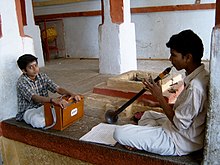Shrutibox

The shrutibox , also surpeti, swar-peti , is a musical instrument that is used in Indian music to produce drone tones to accompany singing. The acoustic shrutibox has punch tongues that are supplied with air by means of a manually operated bellows. In addition, an electric model is used, the sound of which is generated by a synthesizer .
Design and style of play
Shruti means the 22 micro-tones ( shrutis ) with which the octave is divided in Indian music and the fundamental tone ( tonic ) of the modal scale ( raga ). The construction of the acoustic shrutibox corresponds to an Indian harmonium without keys. The size of the flat wooden box is typically 26 centimeters in height, 35 centimeters in width and 11 centimeters in depth, according to other information 20 × 32 × 5 centimeters. On the front there are individual keys for the eight pipes. The range is one octave .
When playing, air is pumped through the box by hand. The desired tone, the flap of which is opened, sounds as a continuous tone. The range of the electric instruments is different.
The shrutibox is a drone instrument for singing accompaniment. In India it replaces the long-necked tanpura of classical music in popular and devotional music . In the West it is used to accompany overtone singing .
Other Indian drone instruments are the double- reed instrument ottu (similar to the South Indian nadaswaram ), the pungi wind instrument used by snake charmers and the single-stringed spit lute ektara . The swarmandal box zither without a fingerboard is used to accompany vocals, but not as a drone instrument.
Web links
- Surpeti. Wind instrument. Indian Net Zone
- Ashwin Batish: Musical Instruments of India Series. Shruti box. Batish Institute of Indian Music and Fine Arts
- David Courtney: Surpeti (Swar Peti) or Shruti Box (Indian Drone Instrument). chandrakantha.com
- Michael Völkel: Mantra in G minor . LWL Museum for Archeology in Herne
Individual evidence
- ↑ Richard Emmert et al. a .: Description of Musical Instruments. In the S. (Ed.): Dance and Music in South Asian Drama. Chhau, Mahākāli pyākhan and Yakshagāna. Report of Asian Traditional Performing Arts 1981. Academia Music Ltd., Tokyo 1983, p. 300
